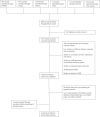Systematic review of surveillance systems for AMR in Africa
- PMID: 36227707
- PMCID: PMC9780554
- DOI: 10.1093/jac/dkac342
Systematic review of surveillance systems for AMR in Africa
Abstract
Aims: Surveillance is a useful tool for tracking antimicrobial resistance (AMR) trends, patterns, therapeutic and policy interventions. Proper correlation of surveillance data gives meaningful insight into the underlying epidemiology and facilitates development of rational interventions. This comprehensive review aims to identify, classify and assess gaps in Global Antimicrobial Resistance and Use Surveillance System (GLASS) reporting and national action plan (NAP) implementation in Africa.
Methods: Articles published in English were searched across five electronic databases (PubMed, Scopus, Embase, AJOL and Cochrane) and grey literature. Articles were screened against inclusion/exclusion criteria and data from eligible studies were retrieved and analysed. This systematic review was registered in the International Prospective Register of Systematic Reviews (PROSPERO) on 31 July 2020 under protocol CRD42020192165.
Results: Of the 4304 records found, only 32 met the initial inclusion criteria (4 peer reviews and 28 were grey literature). From these records, 41 surveillance systems were identified (30 national and 11 transnational). After final review of reported outcomes, only 23 national surveillance systems met the inclusion criteria. Indicators recorded from these systems shows lack of external quality assessment (EQA) in some systems and limited reporting of parameters such as infection origin, patient population and pathogen types.
Conclusions: The outcome of the review shows that although AMR surveillance has been implemented in 23 out of the 47 countries in the region, a number of limitations exist in the surveillance methods and reporting protocols that can impair the usefulness, validity and trustworthiness of data generated from these surveillance systems.
© The Author(s) 2022. Published by Oxford University Press on behalf of British Society for Antimicrobial Chemotherapy.
Figures





References
-
- Nsubuga P, White ME, Thacker SBet al. . Public health surveillance: a tool for targeting and monitoring interventions. In: Jamison DT, et al., eds. Disease control priorities in developing countries. The International Bank for Reconstruction and Development, The World Bank, Oxford University Press, 2006. https://www.ncbi.nlm.nih.gov/books/NBK11728/.
-
- Ashraf M, Mustafa BE, Rehman SUet al. . Emergence of antimicrobial resistance, causes, molecular mechanisms, and prevention strategies: a bovine perspective. In: Sadashiv S.O., Sharangouda J.P. eds. Bovine Science—a key to sustainable development. IntechOpen, 2019. 10.5772/intechopen.79757 - DOI
-
- WHO . Antimicrobial resistance: global report on surveillance. 2014. https://www.who.int/publications/i/item/9789241564748.
Publication types
MeSH terms
Substances
LinkOut - more resources
Full Text Sources
Research Materials
Miscellaneous

